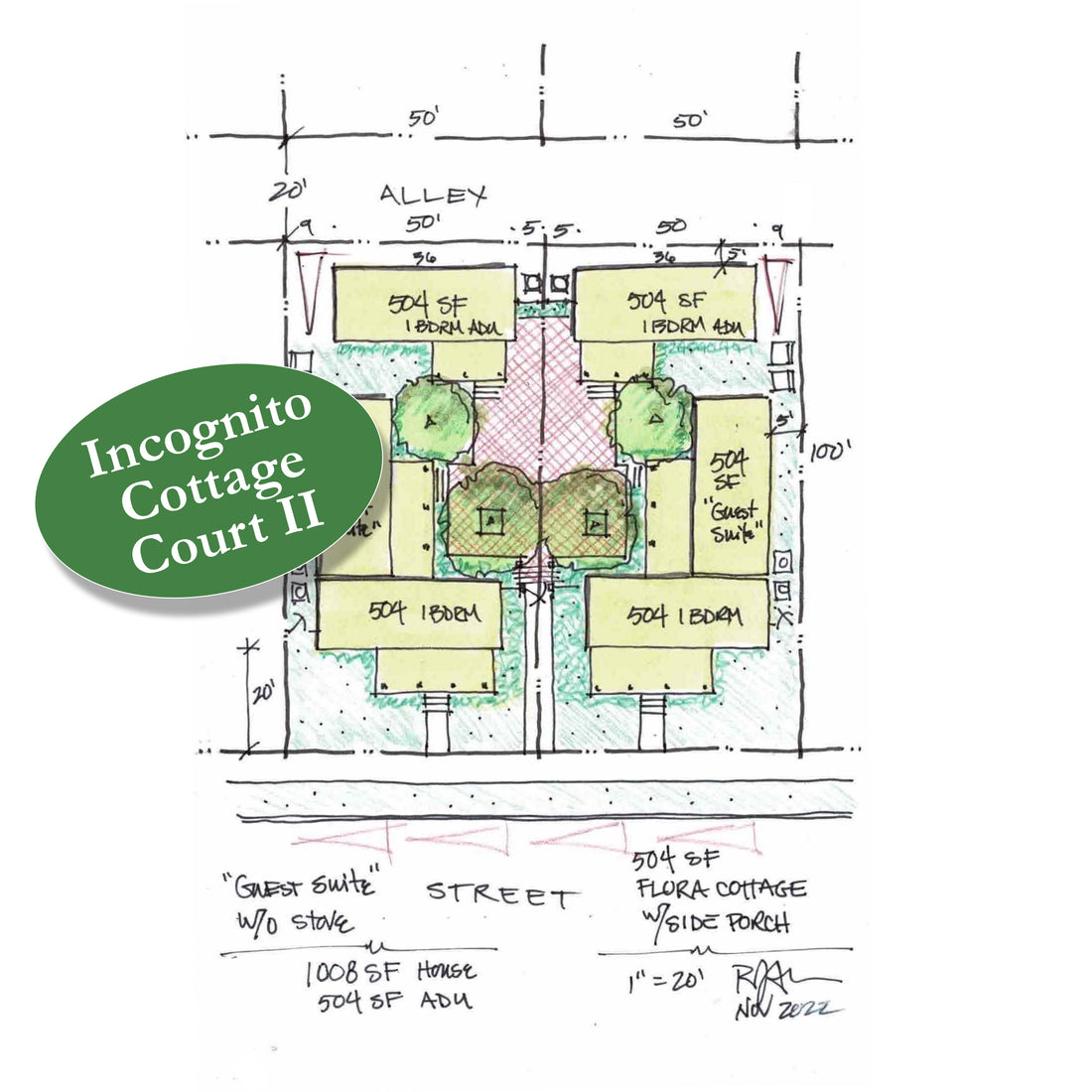Some ideas have legs. The Incognito Cottage Court might be one of them. In twenty-four hours, that post became the tenth most visited page on our website. (Including all of the house plan pages.) One friend reports that he's begun to examine an upcoming real estate purchase with that cottage court strategy in mind.
R. John Anderson sent me a follow-up sketch that shows how flexible the idea can be. This version also uses two lots, each fifty feet wide, with two buildings per lot. Each lot resembles a conventional home with an ADU (accessory dwelling unit) positioned in back.
They read that way because they are single-family homes with ADUs — at least, from a zoning perspective. As John describes it:

The main house is a 1,008 SF two bedroom / two bath. [It consists of] two of the Flora cottage plans connected with a lock-out door to allow the rear unit to function as a "Guest Suite" with a wet bar (but no stove).
Connecting the two Flora units with a door allows the house to be a 1,008 SF 2/2 for the purposes of zoning and appraisals. Locking the door and putting a couple of bookcases in front of it allows the guest suite to function as a separate rental unit with its own entry porch off the courtyard.
Many municipalities that allow Accessory Dwelling Units (ADUs) limit the size of the ADU to half the square footage of the main house or to to some upper limit like 800 SF, whichever is less. The ADU is exactly half the size of the main house in this sketch.
Why build the connected cottage as a Guest Suite?
The building code (IRC & IBC) defines a Dwelling Unit as having "permanent cooking facilities" — a stove, wall oven, or cooktop installed in the countertop. The Guest Suite is not a separate Dwelling Unit, because it doesn't have permanent cooking facilities. It does have a heck of a wet bar with a small refrigerator, a sink, and a collection of cooking appliances that sit on the counter without being permanently installed (air fryer/convection toaster oven, microwave, coffee maker, and a plug-in dual induction burner).
While it is not technically a second Dwelling Unit for zoning or building permit purposes, it is a second rentable unit (utilities included).
In other words, this strategy enables you to achieve the form of a six-unit cottage court on land that's zoned for a simple house with ADU.
In the midst of these technical considerations, let's not forget the key feature of this siting strategy: a cottage court like this would be a beautiful place to live. You don't have to be a connoisseur to make a decision in favor of building beautiful places. Common sense and academic research point to the same conclusion: that beauty correlates with financial value in real estate.
So how do you decide whether this version of the Incognito Cottage Court strategy is right for you?
- Check your local zoning code to see what's allowed on the property where you'd like to build. Carefully examine the Definitions section, where "dwelling unit" is defined. The purpose of this strategy isn't simply to build a cottage court. It's to build one as of right, without the headaches and risks that accumulate when rezoning or a variance is required.*
- Sketch a preliminary site plan to ensure the intended design will fit on your property. Pay special attention to the setbacks and parking requirements that are defined in the development code.
- Do the math. Does the project make financial sense?
Keep in mind that, to succeed with a cottage court, we need to treat it with a level of care that we don't typically give to items in our back yard. From John:
I would look for alternatives to turf. Try pavers, crushed limestone, crushed slate, or pea gravel, for the interior pathways and hardscape, with landscape plantings along the buildings' foundations.
Figure out where you will place the gas and electric meters, the A/C condensers, and the trash and recycling bins. Keep them out of the courtyard if at all possible. Think in terms of deliberate fronts and backs. Utility functions belong in the back if the courtyard is going to be an appealing shared space.
If A/C condensers are not allowed in your local side setbacks, squeeze the dimension of the interior court a bit so that you can place the condensers in the side yard. The suitcase-type condensers that are sold with a number of the ductless min-split heat pump setups have a smaller footprint than the typical condensers for the typical fan coil AC systems.
Keep in mind that you'll have to include utilities in the rent of the front house, since you're technically renting two part of the same home, not a separate dwelling unit.
Financing an Incognito Cottage Court is simpler than you might think.
Need more information to complete the picture? Check out the following posts from John's blog. And when you're ready for house plans, let us know. We'll help you make your cottage court real.
Warm regards,
Jennifer Krouse, Founder and CEO
Further reading by R. John Anderson:
- "Template for Sorting Out a Zoning Code"
- "Sorting through the Small Developer Basics; Land Cost, Total Project Cost, and Likely Rents"
* From the NYC Glossary of Zoning Terms, "An as-of-right development complies with all applicable zoning regulations and does not require any discretionary action by the City Planning Commission or Board of Standards and Appeals."
